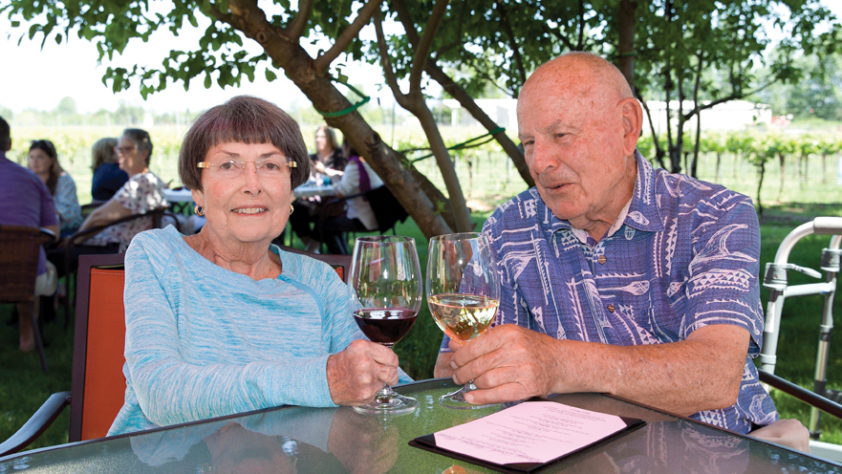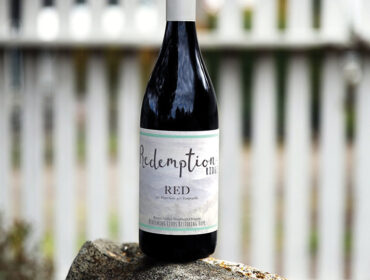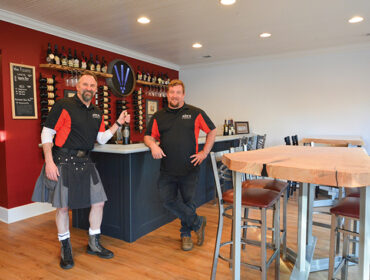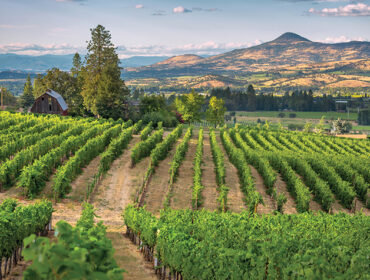
The Grape in Your Glass: Marsanne, Roussanne and Viognier at Daisy Creek Vineyards – by MJ Daspit
For this installment in our series about distinctive varietals that thrive in Southern Oregon, the focus is on three white wine grapes that appear together so often that aficionados refer to them in one fell swoop as ‘MRV.’ Marsanne, Roussanne and Viognier—white counterparts of Syrah that come from the Rhone Valley of France, an area generally warmer than Burgundy or Bordeaux. These distinctive dry white wines are known for crisp acidity, heady fragrance and full body.
In Southern Oregon, interest in Rhone varieties began with Viognier. Planted with increasing frequency in the Rogue Valley over recent years, vineyard plantings in Viognier hit a peak of 186 acres in 2014, 72% of all the Viognier in the state, according to the Oregon Vineyard and Winery Report published in August 2015.
Russ and Margaret Lyon were among the first local growers to take an interest. After Russ retired from a career in the US Navy and ten years teaching ocean engineering at Oregon Tech in Klamath Falls, the Lyons took up residence on a twenty-plus acre parcel on the east side of Jacksonville with the intent of becoming “gentleman farmers.” They started a vineyard in 1997 with a few acres of Merlot. “We knew nothing about grapes,” Russ Lyon recalls. “We happened to meet the winemaker at Valley View, John Guerrero, after we’d been here about two years. John knew our property right at the end of Shafer Lane. That’s a great spot for grapes, he said, nice and warm.”
During the heyday of gold fever in Jacksonville, that spot at the end of Shafer Lane that would become the Lyons’ vineyard was the site of a slurry mine, where prospectors worked the sands and gravels of Daisy Creek for gold. Today the creek’s alluvial deposits create perfect soil conditions for viticulture. The warm temperatures of the site make it similar to the Northern Rhone region of France known as the Côte-Rôtie or “Roasted Slope,” where Viognier is famously inter-planted and co-vinified with Syrah.
Russ learned about viticulture through experience and collaboration with pioneer growers who’d formed the Rogue Valley Winegrowers Association in 1982. He recalls the Association meeting where he first encountered Viognier. “John Guerrero brought a gallon of home wine to one of these meetings. He passed out some paper cups and we tried some. It was Viognier. No one had heard of Viognier. Well, it was a big hit.”
Lyon put in Viognier about the same time as fellow grower Randy Gold. Gold, whose Gold Vineyard was planted in 1982, recalls grafting-over some Merlot vines to Viognier in 2000. The fruit was in demand for wines by A to Z, Weisinger Family Winery and Trium. By 2005-6, Gold had grafted-over a total of four acres.
“We put in a couple of acres and then got really interested in Rhone varietals and thought about Marsanne and Roussanne,” Lyon continues. “Everybody said they make a wonderful blend, and blends were coming in then, so we planted a couple more acres of that. Our Marsanne/Roussanne blend was called Double Play and we added an MRV blend called Triple Play.” If you think the names have to do with baseball, you’re right. Lyon admits to being a fan of the game. His white Rhone blends have a fan following as well, having won numerous awards in recent years including Best of Show at the 2010 World of Wine competition for the Daisy Creek 2009 Triple Play.
Brian Denner, Simple Machine owner/winemaker, who made Daisy Creek vintages from 2011 through 2016, attributes the excellence of the wines to impeccable farming. “Martine Guzman, the Daisy Creek vineyard manager, does great work. These years were some of the hottest on record so the fruit was really ripe and so clean and healthy you could pretty much put your hands in your pockets when it went by on the sorting table. When you’re given really good grapes it’s not hard to turn them into good wine.”
Denner adds some thoughts about crafting Rhone varietals compared to making Bordeaux and Bungundy. On a spectrum, he explains, “Rhones are the middle ground between Bordeaux which are big and chunky, tannic, and very forgiving and Pinot Noir which is very unforgiving, meaning it shows any kind of slip-up in the vineyard or winery and reveals in the glass everything that happens to it. Rhone varietals are in that sweet spot in the middle. You can think outside the box, like maybe trying a whole-cluster ferment if you want to.” He notes the local Rhone varietals coming from warm areas like Eagle Point can mimic “an Australian fruit bomb style,” whereas the same varieties from Jacksonville or the Applegate Valley will yield wine in the Northern Rhone style, “dark and peppery, with more tannin.”
Showcasing Northern Rhone style whites, Daisy Creek produces varietal wines of Marsanne, Roussanne and Viognier as well as the Double and Triple Play blends—a winning line-up if ever there was one.
©Southern Oregon Wine Scene
Summer 2018 issue
Related Post
RoxyAnn Winery–Making a Difference with Redemption...
Update to this article on 07/29/21 – “… the Board of Directors of Redemption Ridge have made the difficult decision to clo...
Awen Winecraft: An Inspirational New Reason...
As if you needed another reason to visit historic Jacksonville, now there’s another draw—Awen Winecraft’s new tasting room located at ...
Rogue Valley Rising – by Valerie...
MEDFORD, OREGON’S star is rising on the world stage as it rapidly becomes a top destination for connoisseurs of fine wine and for enthusia...




